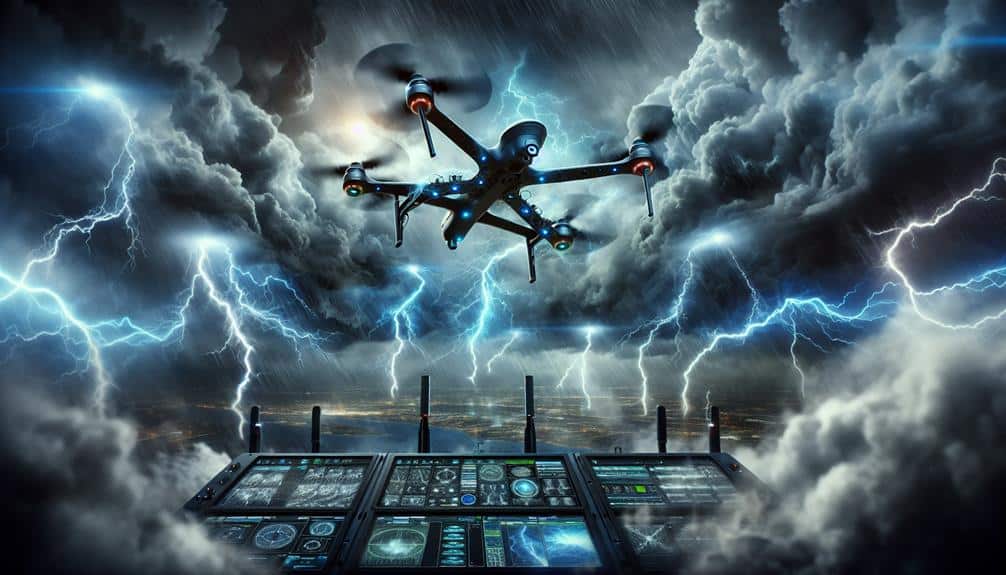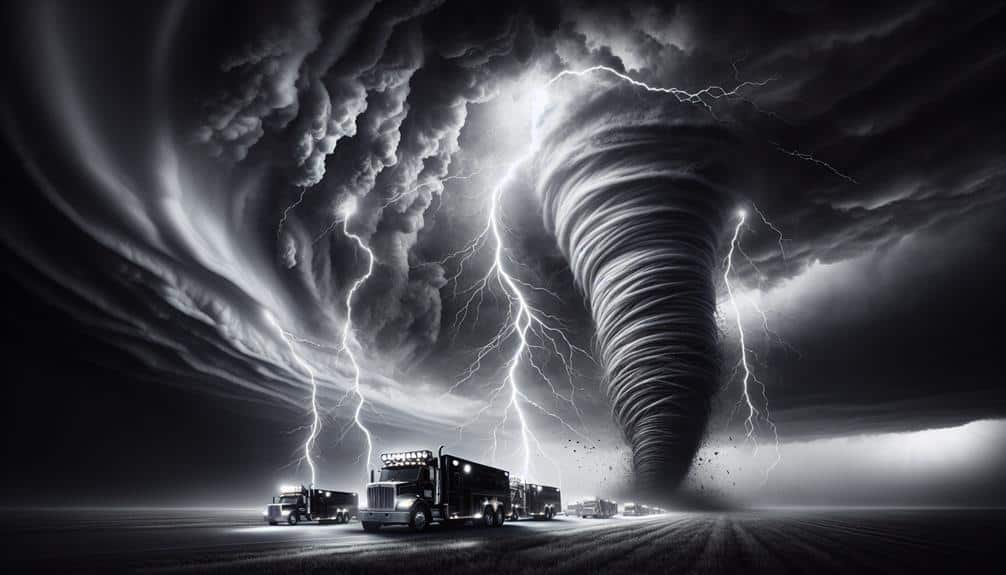For storm chasing monitoring, we recommend drones with advanced stabilization and high wind resistance, such as the DJI Matrice 300 RTK. These drones should feature robust aerodynamics, powerful motors, and high-tensile strength materials. We also value high-resolution cameras, like 4K or 8K with advanced gimbal systems, to capture real-time atmospheric data. Long battery life is essential for extended flights, paired with low-latency data transmission capabilities for seamless real-time updates. Models like the DJI Phantom 4 Pro V2.0 exemplify these features, ensuring minimal downtime and enhanced performance in extreme weather conditions. To explore specific models and their specs, continue below.
Key Points
- Drones with advanced stabilization systems and high wind resistance ensure reliable performance in extreme weather conditions.
- Long battery life is crucial for extended storm chasing missions without frequent interruptions.
- High-resolution cameras with 4K or 8K capabilities provide detailed imagery and accurate weather tracking.
- Real-time data transmission capabilities are essential for on-the-spot analysis and decision-making during storm events.
Top Features for Storm Chasing Drones
When selecting drones for storm chasing, we should prioritize features such as advanced stabilization systems, high wind resistance, long battery life, and real-time data transmission capabilities. These attributes guarantee our drones can withstand severe weather conditions while providing us with accurate, timely data.
Remote control and weatherproof drones are essential in storm chasing scenarios. Remote control functionality allows us to maneuver the drone with precision, even from a significant distance, making sure we stay safe while gathering critical data. Weatherproof drones, designed to endure rain, snow, and high winds, ensure operational reliability under extreme conditions.
Moreover, lightweight, agile drones offer the versatility required for rapid deployment and swift navigation through turbulent environments. Their reduced mass and enhanced maneuverability make them less susceptible to wind drift, making sure they remain stable and responsive.
Integrating advanced stabilization systems further enhances their performance, providing smooth footage and precise sensor readings, even in turbulent airflows.
Durable Drones for Extreme Weather
Building on the need for advanced features in storm chasing drones, we must also focus on the durability of these drones to guarantee they can withstand extreme weather conditions. Our primary objective is to maintain the equipment remains operational in the face of heavy rainfall, intense winds, and other harsh elements.
Waterproof drones are essential; they must exhibit a high Ingress Protection (IP) rating, ideally IP67 or higher, to protect against water ingress during torrential downpours.
Wind resistant drones, on the other hand, require robust aerodynamics and powerful motors to sustain stability in wind speeds exceeding 30 mph. We should prioritize models equipped with advanced gyroscopic stabilization and real-time wind resistance algorithms. This maintains the drones can hold their position and capture critical data without succumbing to erratic atmospheric disturbances.
Additionally, the structural integrity of these drones must be examined. High-tensile strength materials such as carbon fiber and reinforced polymers provide the necessary resilience against high-impact forces. By integrating these features, we can deploy drones that not only excel in data collection but also offer the durability needed to navigate the perilous conditions inherent to storm chasing.
This approach guarantees we can continue our pursuits with confidence and minimal downtime.
High-Resolution Camera Drones
For storm chasing, deploying drones equipped with high-quality cameras is vital for capturing detailed meteorological data and high-definition imagery. High-quality camera drones allow us to obtain precise aerial photography and real-time weather tracking, providing invaluable insights into storm dynamics. By leveraging drones equipped with 4K or even 8K cameras, we can capture every intricate detail of cloud formation, lightning activity, and wind patterns.
High-quality sensors, such as those with 20-megapixel or higher capabilities, enhance our ability to identify storm characteristics that aren't visible to the naked eye. These sensors facilitate accurate data collection, enabling us to create more precise predictive models. Additionally, drones with advanced gimbal stabilization systems make sure that our footage remains steady, even in turbulent conditions, which is essential for detailed analysis.
Moreover, integrating thermal imaging cameras can enhance our weather tracking efforts. These cameras can detect temperature variations within storm systems, offering another layer of crucial data. We can then correlate these thermal images with standard visual recordings to gain a complete understanding of storm behavior.
In essence, high-quality camera drones empower us to capture and analyze storm data with exceptional clarity, ultimately enhancing our ability to predict and respond to severe weather events.
Long Battery Life Drones
To maximize our storm chasing capabilities, we must deploy drones with extended battery life to guarantee prolonged operational periods without frequent interruptions for recharging. This endurance is essential when monitoring unpredictable weather patterns. Drones like the DJI Matrice 300 RTK, with a flight time of up to 55 minutes, provide the necessary longevity.
By using lightweight drones, we secure portability and ease of deployment in dynamic storm chasing scenarios. Remote control and autonomous flight functionalities further enhance our operational efficiency. The DJI Phantom 4 Pro V2.0, for instance, combines these features with a 30-minute battery life, offering a balanced solution.
Autonomous flight paths allow us to program the drone to follow specific routes, capturing consistent data while we focus on real-time analysis. Moreover, portable drones such as the Parrot Anafi USA, which boasts a 32-minute flight time, ensure that we can quickly reposition and redeploy as the storm evolves.
The emphasis on prolonged battery life minimizes downtime, enabling continuous data collection and maximizing our responsiveness.
Real-Time Data Transmission Drones

Seamless real-time data transmission is necessary for effectively tracking and analyzing storm developments while we're in the field. When we utilize drones with cutting-edge transmission capabilities, we enhance our ability to make swift, informed decisions important to our operations. High-frequency data links and low-latency communication systems are non-negotiable. These features guarantee that the data we collect is immediately accessible, minimizing delays that could compromise our situational awareness.
Drones like the DJI Matrice 300 RTK and the Parrot Anafi USA excel in this domain. Both models offer robust connectivity options, allowing us to maintain remote control even in adverse weather conditions. This capability is essential for steering the drones through unpredictable storm patterns and ensuring they capture critical data.
Moreover, the ability to transmit high-resolution imagery and atmospheric readings in real time directly impacts our emergency response strategies. When we can see storm behavior as it unfolds, we can relay accurate information to emergency services, optimizing their response efforts. High-bandwidth transmission systems integrated into these drones facilitate this level of detailed, instantaneous data sharing.
Frequently Asked Questions
What Are the Legal Requirements for Flying Drones During Storms?
We must follow drone regulations and prioritize safety when flying during storms. For storm monitoring, technology like GPS and real-time data transmission is essential. Guarantee compliance with FAA guidelines, including altitude limits and no-fly zones.
How Can Drones Be Safely Operated in High Wind Conditions?
Oh sure, let's just send our drones into a tornado! With high wind resistance and rigorous safety measures, we can guarantee operational stability, using gyroscopic stabilization and real-time wind data to keep our freedom-loving drones airborne.
What Training Is Necessary for Storm Chasing Drone Pilots?
We need extensive training for storm chasing drone pilots, including pilot certification, storm safety protocols, advanced weather knowledge, and emergency procedures. This guarantees precise maneuvering and safety, allowing us to capture critical data while minimizing operational risks.
Are There Specific Insurance Policies for Using Drones in Storm Chasing?
Ye olde days of guesswork are over! We need specific insurance coverage for storm chasing drones. This includes liability and risk management. Regulations mandate policies tailored for drone usage, ensuring we manage risks while enjoying the freedom of flight.
How Do Storm Chasing Drones Handle Potential Lightning Strikes?
We guarantee flight safety by equipping storm chasing drones with lightning protection and enhancing drone durability. Emergency protocols are in place to mitigate risks, and precise terminologies dictate our approach, securing freedom in data collection during severe weather.
